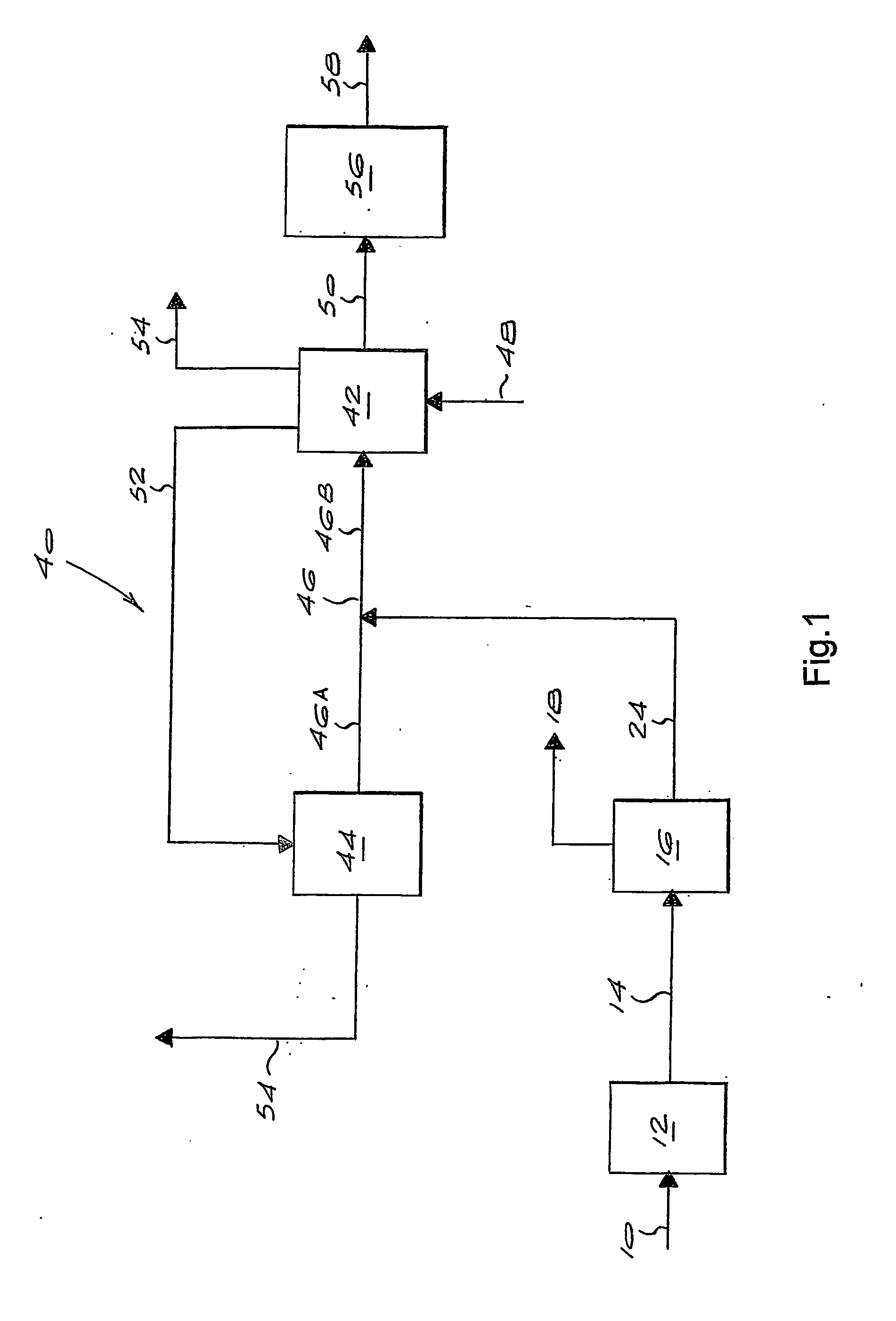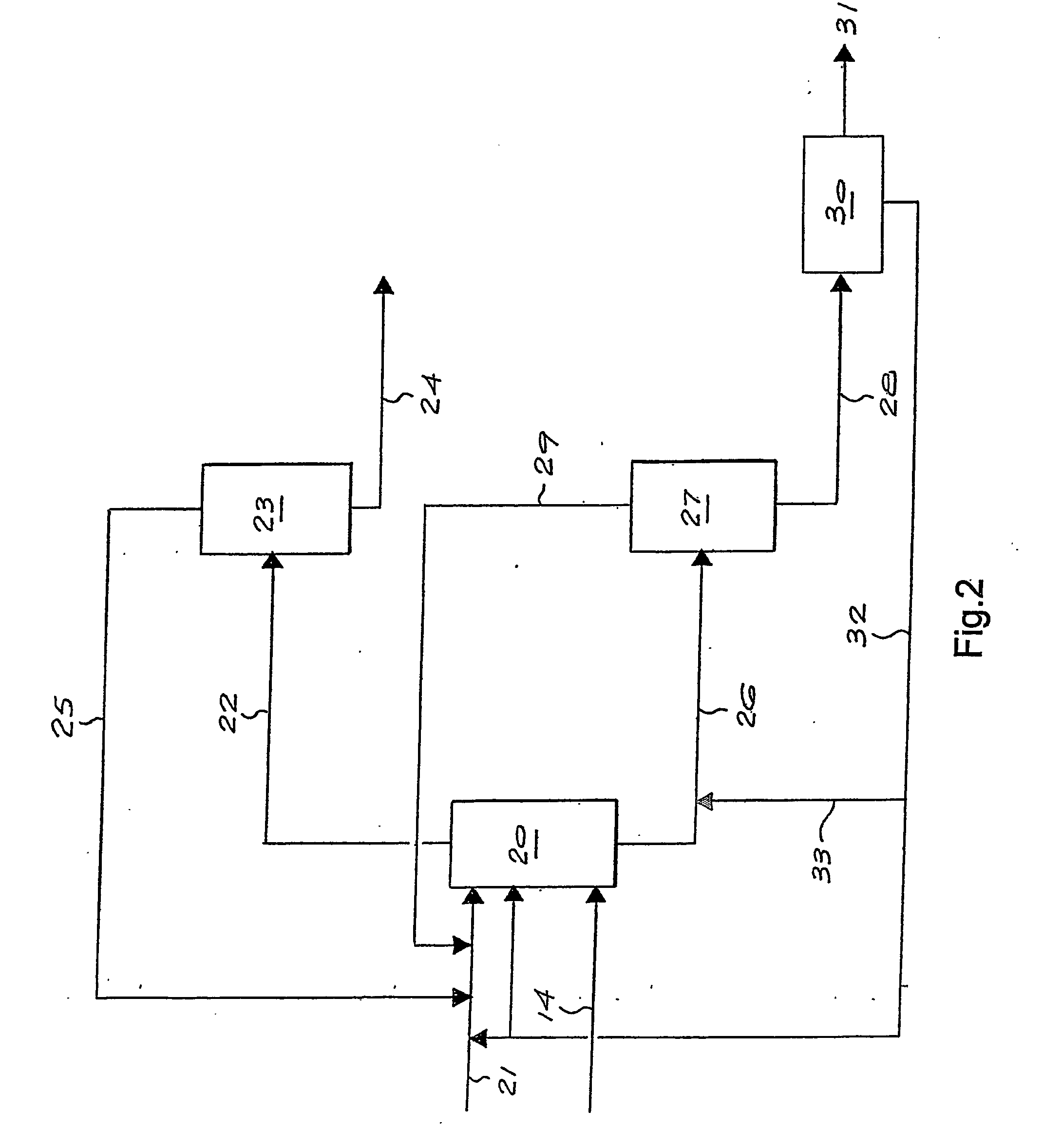Production of linear alkyl benzene
a technology alkyl benzene, which is applied in the field of production of linear alkyl benzene, can solve the problems of poor quality linear alkyl benzene, the only feasible process for feeds, and the relative high cost of paraffinic starting material and high cost associated with the production of linear paraffins from kerosene feedstocks. achieve the effect of enhancing the overall recovery of olefins and par
Inactive Publication Date: 2007-02-15
SASOL TEKHNOLODZHI PROPRIEHJTEHRI LTD
View PDF6 Cites 15 Cited by
- Summary
- Abstract
- Description
- Claims
- Application Information
AI Technical Summary
Benefits of technology
[0018] In a preferred embodiment of the invention the oxygenate extraction process is a liquid-liquid extraction process that preferably takes place in an extraction column using a mixture of methanol and water as the solvent, wherein an extract from the liquid-liquid extraction is sent to a solvent recovery column from which a tops product comprising methanol, olefins and paraffins is recycled to the extraction column, thereby enhancing the overall recovery of olefins and paraffins. A bottoms product from the solvent recovery column may also be recycled to the extraction column. The solvent preferably has a water content of more than 3% by weight, more preferably a water content of about 5%-15% by weight. A raffinate from the extraction column may be sent to a stripper column from which a hydrocarbon feed stream containing more than 90% by weight olefins and paraffins and typically less than 0.2% by weight, preferably less than 0.02% by weight oxygenates exits as a bottoms product. Preferably the recovery of olefins and paraffins in the hydrocarbon feed stream is in excess of 70%, more preferably in excess of 80%, while the olefin / paraffin ratio is at least substantially preserved.
Problems solved by technology
A problem with this approach is the relatively high cost of paraffinic starting material and the high cost associated with the production of linear paraffins from kerosene feedstocks.
This reference states that Fischer-Tropsch feedstock produced results in poor quality Linear Alkyl Benezene due to odour and wetting problems caused by carbonyl i.e. oxygenate content of the Fischer Tropsch feedstock.
This process is only feasible for feeds with low oxygenate concentrations.
Method used
the structure of the environmentally friendly knitted fabric provided by the present invention; figure 2 Flow chart of the yarn wrapping machine for environmentally friendly knitted fabrics and storage devices; image 3 Is the parameter map of the yarn covering machine
View moreImage
Smart Image Click on the blue labels to locate them in the text.
Smart ImageViewing Examples
Examples
Experimental program
Comparison scheme
Effect test
example
[0091] This example shows a process according to the invention. The extraction column 20 was run at a solvent to feed ratio of 1.25 and a temperature of 50° C. The overall olefin / paraffin recovery in the stream 24 was 89.9%. The olefin / paraffin ratio in the feed was 1:3.7 and 1.36 post oxygenate extraction. The olefin / paraffin ratio was therefore substantially preserved.
the structure of the environmentally friendly knitted fabric provided by the present invention; figure 2 Flow chart of the yarn wrapping machine for environmentally friendly knitted fabrics and storage devices; image 3 Is the parameter map of the yarn covering machine
Login to View More PUM
| Property | Measurement | Unit |
|---|---|---|
| Temperature | aaaaa | aaaaa |
| Temperature | aaaaa | aaaaa |
| Fraction | aaaaa | aaaaa |
Login to View More
Abstract
This invention relates to a process for producing linear alkyl benzene, the process including the steps of obtaining a hydrocarbon condensate containing olefins, paraffins and oxygenates from a low temperature Fischer-Tropsch reaction; a) fractionating a desired carbon number distribution from the hydrocarbon condensate to form a fractionated hydrocarbon condensate stream; b) extracting oxygenates from the fractionated hydrocarbon condensate stream from step (a) to form a stream containing olefins and paraffins; c) combining the stream containing olefins and paraffins from step (b) with the feed stream from step (g) to form a combined stream; d) alkylating olefins in the combined stream from step (c) with benzene in the presence of a suitable alkylation catalyst in an alkylation reactor, e) recovering linear alkyl benzene from the alkylation reactor; f) recovering unreacted paraffins from the alkylation reactor; g) dehydrogenating the unreacted paraffins in the presence of a suitable dehydrogenation catalyst to form a feed stream containing olefins and paraffins; and h) sending the feed stream containing olefins and paraffins from step (g) to step (c).
Description
BACKGROUND OF THE INVENTION [0001] THIS invention relates to a process for producing linear alkyl benzene. [0002] Alkyl benzene derivatives, such as alkyl benzene sulphonates, are among others, used in detergent and surfactant product applications. Environmental legislation requires that these products are biodegradable. It is well known that, to be bio-degradable, it is important for the alkyl chain to be linear, i.e. with very little or no branching and low, if any, quatemary carbons. [0003] In conventional processes for producing linear alkyl benzenes, a hydrocarbon stream is hydrogenated in order to remove contaminants such as sulphur, nitrogen and oxygen contaminants that may be present. Hydrogenation also converts olefin species in the stream to paraffins. Following the hydrogenation reaction, the resulting paraffin stream is fractionated into various carbon ranges. A carbon range, for example the C8 to C16 range, which includes branched paraffins, is passed through a molecula...
Claims
the structure of the environmentally friendly knitted fabric provided by the present invention; figure 2 Flow chart of the yarn wrapping machine for environmentally friendly knitted fabrics and storage devices; image 3 Is the parameter map of the yarn covering machine
Login to View More Application Information
Patent Timeline
 Login to View More
Login to View More IPC IPC(8): C07C13/00C07C4/00C07C7/10C10G2/00C10G29/20
CPCC07C2/66C07C7/04C07C7/10C10G2/32C10G29/205C10G2400/10C10G2300/1022C10G2300/1096C10G2300/301C10G2300/4081C10G2300/44C10G2400/30C07C2/70C07C15/00
Inventor GREAGER, IVANSCHOLTZ, JAN HENDRIKDE WET, JOHAN PIETERDESMET, MIEKE ANNJANSEN, WILHELMINAJACOBSON, PAULDANCUART, LUIS PABLO FIDEL
Owner SASOL TEKHNOLODZHI PROPRIEHJTEHRI LTD
Features
- R&D
- Intellectual Property
- Life Sciences
- Materials
- Tech Scout
Why Patsnap Eureka
- Unparalleled Data Quality
- Higher Quality Content
- 60% Fewer Hallucinations
Social media
Patsnap Eureka Blog
Learn More Browse by: Latest US Patents, China's latest patents, Technical Efficacy Thesaurus, Application Domain, Technology Topic, Popular Technical Reports.
© 2025 PatSnap. All rights reserved.Legal|Privacy policy|Modern Slavery Act Transparency Statement|Sitemap|About US| Contact US: help@patsnap.com



